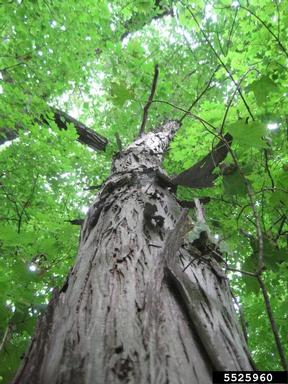Shagbark Hickory
 Native Range
Native Range
Carya ovata, or Shagback Hickory, is native to Kansas and Eastern United States.
Mature Size
It is a large tree with a broad, round crown reaching a height of 65 to 90 feet.
Growth Rate
Shagbark Hickory has a moderate growth rate. It may take several years for the roots to get established before it grows much in height.
Leaves, Stems and Fruit
The compound leaves have typically 5 leaflets ranging 3 to 7 inches long and are borne alternately on the stem. They are a yellow-green color and turn golden yellow in the fall. The fruit is a nut. The mature bark is grayish- brown with long strips or shaggy in appearance.
Use
Timber - Shagbark Hickory is an excellent timber species. This hardwood is used in the production of wood for furniture, firewood, and to smoke meats.
Wildlife Habitat - Shagbark Hickory nuts are a good food source for wildlife.
Adaptation and Soil
Shellbark Hickory has adapted statewide and grows best on deep, fertile bottomland soils. It tolerates some wet soils and clay soils. Grows in full to part sun.
Spacing
Spacing for timber and nut plantings are 15 x 15 feet or greater spacing to allow larger growth. Periodic thinnings during the life of the stand are used to reduce the number of trees for maximum productivity.
Culture
One-year- old, bare root seedlings, 18 to 24 inches tall. Shagbark Hickory can be planted successfully if the site is properly prepared, and good weed control is practiced. Initial growth is slow but accelerates once the root system becomes established.
Pests
Shagbark Hickory leaves are a favorite food of the tent caterpillar. Several pests, such as the shuck worm and weevils, may cause damage to the nuts if not controlled. Generally, diseases are not a serious problem.
Soil Information
| Average Height in 20 Yrs: | |
| -Eastern | 24-30 ft. |
| -Central | Not Suitable |
| -Western | Not Suitable |
| Growth Rate: | Slow |
| Native Species: | Native to Kansas |
| Windbreak Value: | Medium |
| Wildlife Value: | High |
| Lumber Products: | Yes |
| Fuelwood Products: | Yes |
| Drought Tolerance: | Medium |
| Texture: | 1,2,3 |
| Soil Saturation: | Medium Tolerance |
| Salinity Tolerance: | No Tolerance |
| pH Range: | 4-7.4 |